#2019 Toyota Rav4 Apple Carplay
Explore tagged Tumblr posts
Text
2020 Toyota RAV4 Redesign, Price, Specs
2020 Toyota RAV4 Redesign, Price, Specs
2020 Toyota RAV4 Redesign, Price, Specs– Presently you are probably aware an all-new 2020 Toyota RAV4 is approaching in the after that several months. Therefore we are not able to wait for it. We wanted to present you with some useful info on the specs & features of the crossover. However, many of the basic specs are still unannounced, so alternatively, we are likely to focus on two of the…
View On WordPress
#2019 Toyota Rav4#2019 Toyota Rav4 Adventure#2019 Toyota Rav4 Adventure Grade#2019 Toyota Rav4 Adventure Price#2019 Toyota Rav4 Adventure Specs#2019 Toyota Rav4 Android Auto#2019 Toyota Rav4 Apple Carplay#2019 Toyota Rav4 Auto Show#2019 Toyota Rav4 Availability#2019 Toyota Rav4 Awd#2019 Toyota Rav4 Awd System#2019 Toyota Rav4 Colors#2019 Toyota Rav4 Hybrid#2019 Toyota Rav4 Interior#2019 Toyota Rav4 Limited#2019 Toyota Rav4 Mpg#2019 Toyota Rav4 Pictures#2019 Toyota Rav4 Price#2019 Toyota Rav4 Redesign#2019 Toyota Rav4 Specs
0 notes
Text
2023 Toyota RAV4 update revealed for Japan Australia to follow
The Toyota RAV4 has received another update in Japan, ahead of Australian arrivals before the end of this year. 0 View 8 images The updated 2023 Toyota RAV4 has been revealed for Japan, ahead of Australian showrooms arrivals due by the end of 2022. After a handful of images of the updated 2023 RAV4 were published in Europe, it’s Toyota Japan’s turn to reveal elements of the updated model, which introduces a number of technology and safety updates to keep it fresh among newer rivals. Toyota dealers in Australia have been advised to expect price rises of $1500 to $3000, depending on the model – in addition to an inflation-related price rise of $1500 across all RAV4 variants from 1 January 2023. As reported by Drive previously, from 16 May 2022 Toyota dealers began advising customers the final price of their vehicle was subject to change due to model-year upgrades or increased manufacturing costs – and they are entitled to a refund of their deposit if they don’t agree with the new prices, or don’t want to wait. View 8 images View 8 images PreviousNext With wait times out to 18 months on some RAV4 variants, vehicles ordered today may not be the car that eventually arrives – passing through one or possibly two model-year upgrades, bringing with them more features which command a higher list price. As previously reported by Drive, all models gain new infotainment software, with wireless Apple CarPlay, Android Auto, a smarter cloud-based satellite navigation system, and a ‘Hey Toyota’ voice assistant. It’s set to run on an 8.0-inch touchscreen in the entry-level GX and GXL models in Australia, while the XSE, Cruiser and Edge locally – or high-end models in Japan – are slated to adopt a new 10.5-inch touchscreen. View 8 images View 8 images PreviousNext There’s a 12.3-inch digital instrument cluster – set to feature on Australian XSE, Cruiser and Edge variants – while the 7.0-inch instrument display previously in these models is slated to be added to the GX and GXL (replacing a 4.2-inch screen). Advanced safety technology improvements outlined by Toyota Japan include a revised autonomous emergency braking system capable of braking for oncoming vehicles in an intersection, or pedestrians crossing a side street the car is turning into. Japanese models also add a Nanoe-X air filtration system and a “recording function” for the available digital rear-view mirror as new for 2023 – but these aren’t believed to be on the cards for Australia for the time being. Toyota dealers have been advised of further upgrades to Australian RAV4s not listed in the Japanese announcement, including an emergency steer assist safety feature, and support for the Toyota Connected Services suite of connected-car features, powered by a smartphone app. USB-C ports are slated to replace USB-A sockets across the range in Australia, while the flagship Edge is set to gain upgraded LED projector headlights. The 2023 Toyota RAV4 is due in Australian showrooms before the end of this year. Alex Misoyannis has been writing about cars since 2017, when he started his own website, Redline. He contributed for Drive in 2018, before joining CarAdvice in 2019, becoming a regular contributing journalist within the news team in 2020. Cars have played a central role throughout Alex’s life, from flicking through car magazines at a young age, to growing up around performance vehicles in a car-loving family. Read more about Alex Misoyannis Source link Originally published at Melbourne News Vine
0 notes
Text
best cheap electric car | best cheap electric car
With 9M CR-Vs sold globally, Honda debuts its CR-V Hybrid
The Honda CR-V has an incredible record of global sales. More than 9 million CR-Vs have been sold worldwide in 150 countries since ’95. In the USA, a total of 384,168 CR-Vs were sold in 2019 alone (wheelsjoint.com). In the SUV market, it ranks second only to the Toyota RAV4.

By John Coulter, CURRENT EV CMO
Launched in Japan in 1995, the CR-V became one of the pioneer models of what has become the highly popular Compact SUV segment. It quickly established itself as a favorite with customers looking for a sturdy, reliable vehicle with low maintenance costs.
The core of the vehicle’s popularity is its combination of efficiency, functionality, simple style, safety and legendary Honda quality. The average estimate for repair bills for the first and second years is $0! The average maintenance cost for the first year of driving is $190.
Depreciation is minimal as well, accounting for only 10.582% its first year and 8.88% its second year.
The 2021 Honda CR-V Hybrid crossover retains the same basic design and features as its 2020 predecessor. Few changes have been implemented, as 2020 was the year when the CR-V received its 4th Generation makeover and the hybrid version debuted. The 2021 hybrid uses a 2.0L 4-cylinder Atkinson Cycle engine mated with 2 electric motors and a small 1.4kWh battery. Together, they generate 212hp and 232 lb-ft of torque, and provide what is considered the best engine performance in its segment.
With a 0 to 60 sprint of 7.5 seconds, it is not what any reviewer would call a fast car. But what its drivers like is its linear power delivery; it has no gears to shift, making the drive incredibly smooth. And the vehicle’s torque output of 232 lb-ft with its gas engine and two electric motors working bests the Ford Escape Hybrid and the Toyota RAV 4 Hybrid, its two closest competitors. Rather than a super fast family hauler, it’s a comfy city cruiser which gets you where you want to go, smoothly, safely and inexpensively.
Fuel Economy is excellent. The EPA estimates the 2021 CR-V will provide you with 40mpg city, 35mpg highway and 38 combined. The hybrid’s total range is 440 miles.
There are 4 CR-V trims: Hybrid LX (MSRP: $27,850); Hybrid EX (MSRP: $30,360); Hybrid EX-L (MSRP: $32,850); and Hybrid Touring (MSRP: $36,050).
Hybrid LX features include: Real Time AWD; Honda Sensing; an Easy Fold-Down 60/40 Split Rear Seatback; a Power Flow Monitor; ECON, Sport and EV Drive Modes; a Multi-Angle Rearview Camera; LED Headlights with Auto-On/Off; Smart Entry with Walk Away Auto Lock; Auto High-Beam Headlights; an Automatic Climate Control System; Push Button Start; a Retractable Cargo Area Cover; a 160-Watt Audio System with 4 Speakers; Bluetooth HandsFreeLink; USB Audio Interface; Pandora Compatibility; Remote Entry System; Idle-Stop.
Hybrid EX includes all Hybrid LX features, plus: Blind Spot Information (BSI) System with Cross Traffic Monitor; Dual-Zone Automatic Climate Control System; Apple CarPlay Integration; Android Auto Integration; Heated Front Seats; a 12-Way Power-Adjustable Driver’s Seat; One-Touch Power Moonroof with Tilt Feature; 7-Inch Display Audio Touch-Screen; 180-Watt Audio System with 6 Speakers; SiriusXM® Radio; HD Radio; SMS Text Message Function; Rear Privacy Glass; HondaLink; Heated Power Side Mirrors Including Integrated Indicators; Auto High-Beam Headlights; LED Fog Lights; a Security System.
Hybrid EX-L includes all Hybrid LX and EX features, plus: a Leather-Trimmed Interior; a Power Tailgate; a Heated Steering Wheel; Automatic-Dimming Rearview Mirror; a Two-Position Memory Driver’s Seat; a Front Passenger’s Seat with 4-Way Power Adjustment; a 180-Watt Audio System with 8 Speakers; Ambient Lighting; HomeLink Remote System.
Hybrid Touring includes all Hybrid LX, EX and EX-L features, plus: a Hands-Free Access Power Tailgate; a Wireless Phone Charger; 19-Inch Alloy Wheels; Parking Sensors; Honda Satellite-Linked Navigation System; Turn-By-Turn Directions; Roof Rails; 330-Watt Premium Audio System with 9 Speakers; Rain-Sensing Windshield Wipers.
The CR-V offers one of the largest cargo bays in its segment, with 39.2ft3 of cargo space. Car & Driver reviewers managed to fit 10 carry-on sized suitcases behind the rear seat. With seats folded down, the Honda CR-V Hybrid offers best-in-class luggage space.
In 2020, the CR-V earned a 5-star crash-test rating from the National Highway Traffic Safety Administration (NHTSA), and it was named a Top Safety Pick by the Insurance Institute for Highway Safety (IIHS), The Honda also comes standard with a suite of driver assistance technology which includes: standard forward-collision warning and automated emergency braking; standard lane-keeping assist and lane-departure warning; standard adaptive cruise control.
#about electric car#american electric car#batteries for electric vehicles#battery car motor#best buy electric car#best full electric cars
0 notes
Text
2019 Toyota Rav4 Redesign, Engine, Specs
2019 Toyota Rav4 Redesign, Engine, Specs
2019 Toyota Rav4 Redesign, Engine, Specs– Toyota is defined to show its freshest crossover car, the 2019 Toyota Rav4, at the impending 2018 New York Auto Show. This really is a completely new, fifth-age group version which comes several weeks right after the revelation in the 12th-era Corolla hatchback. This auto has become restored and given a more well-off interior as well as a muscular…
View On WordPress
#2019 Toyota Rav4#2019 Toyota Rav4 Adventure#2019 Toyota Rav4 Apple Carplay#2019 Toyota Rav4 Australia#2019 Toyota Rav4 Auto Show#2019 Toyota Rav4 Canada#2019 Toyota Rav4 Changes#2019 Toyota Rav4 Colors#2019 Toyota Rav4 Concept#2019 Toyota Rav4 Debut#2019 Toyota Rav4 Detroit Auto Show#2019 Toyota Rav4 Engine#2019 Toyota Rav4 Forum#2019 Toyota Rav4 Hybrid#2019 Toyota Rav4 Hybrid Release Date#2019 Toyota Rav4 Interior#2019 Toyota Rav4 Price#2019 Toyota Rav4 Redesign#2019 Toyota Rav4 Release Date#2019 Toyota Rav4 Specs#2019 Toyota Rav4 Spied#2019 Toyota Rav4 V6
0 notes
Text
Đánh Giá Toyota Highlander 2020: Thay đổi nhưng chưa đem lại ấn tượng mạnh mẽ
Trước khi phân khúc SUV ba hàng ghế trở nên bùng nổ như ngày nay, Toyota Highlander đích thực là một dòng xe nổi trội trong phân khúc này, mang đến sự phong cách trong thiết kế, sự tiện nghi thoải mái trong trải nghiệm và khả năng vận hành đầy ấn tượng.
Tuy nhiên, trong thời gian gần đây, các đối thủ cạnh tranh trong phân khúc SUV đã thay đổi với thiết kế bắt mắt, công nghệ hiện đại hơn. Để không trở nên lạc hậu trước các đối thủ đầy tiềm năng này, Toyota đã phải nâng cấp Highlander để nó cao cấp và hiện đại hơn.
Trước đó tại Triển lãm ô tô New York 2019, Toyota đã chính thức tung ra Highlander 2020 phiên bản mới với phong cách thiết kế được cải tiến, bổ sung thêm hàng loạt công nghệ cùng tính năng an toàn. Tuy nhiên, Toyota Highlander 2020 vẫn còn tồn tại một số nhược điểm lớn, tiêu biểu như: không gian hàng ghế thứ 3 chật hẹp, kiểu dáng không mới mẻ, hấp dẫn và trên hết là mức giá bán đắt đỏ (phiên bản Platinum có giá 51.000 USD, tương đương khoảng 1,2 tỷ đồng). Chính những nhược điểm này khiến Toyota Highlander 2020 không thể trở thành một lựa chọn hàng đầu trong phân khúc SUV ba hàng ghế đang diễn ra những cuộc cạnh tranh rất khốc liệt.
Thiết kế: 5/10
Dựa trên nền tảng thiết kế mới TNGA-K (Toyota New Global Architecture), Toyota Highlander 2020 sở hữu diện mạo bắt mắt và thể thao hơn. Đặc biệt là phần đầu xe với cụm đèn pha hình thang ngược có xu hướng chạy dốc xuống, bộ lưới tản nhiệt hoàn toàn mới với kiểu dáng hình thang nhỏ gọn đầy tinh tế, thay vì kiểu lưới dao cạo như trên thế hệ tiền nhiệm. Nằm ngay phía trên mặt lưới tản nhiệt là thanh crom sáng bóng với logo Toyota quen thuộc. Nhìn chung, đây được coi là một sự cải tiến trong phong cách thiết kế của Highlander.

Mặc dù được lấy cảm hứng từ đàn em RAV4, nhưng phần thân xe Toyota Highlander 2020 lại mang tới cảm giác mềm mại và thanh thoát hơn, ngoại trừ các đường gân dập nổi chạy dài từ cửa trước tới vòm bánh sau. Bộ la-zăng đa chấu sắc nét cỡ 20 inch trên Highlander 2020 dường như được lấy cảm hứng từ một dòng xe sang trọng nào đó. Thiết kế đuôi xe khá ấn tượng với kiểu dáng sắc nét gợi nhớ đến các dòng xe NX của Lexus, với cụm đèn hậu chạy ngang.

Trong khoang cabin, Highlander 2020 được trang bị một màn hình cảm ứng 8 inch khá bắt mắt nằm ở trung tâm. Trên biến thể Platinum cao cấp là màn hình cảm ứng 12.3 inch – được coi là một trong những hệ thống đa phương tiện lớn nhất phân khúc. Toyota còn khéo léo đặt các điểm nhấn như thanh kim loại màu bạc sắc nét và bọc da màu nâu cao cấp xung quanh khu vực màn hình thông tin giải trí.
Tính năng công nghệ: 6/10

Tương tự như màn hình cảm ứng 12.3 inch trên biến thể Platinum, màn hình 8.0 inch tiêu chuẩn cung cấp hình ảnh sắc nét và chi tiết cùng khả năng hỗ trợ kết nối Apple CarPlay và Android Auto. Hệ thống thông tin giải trí trên Toyota Highlander 2020 khá giống với Starlink của Subaru, có khả năng chia đôi màn hình trung tâm, cho phép vừa hiển thị thông tin giải trí vừa thực hiện chức năng điều hướng.

Ngay cả trên phiên bản thấp nhất là Highlander L, khách hàng cũng được trải nghiệm hệ thống điều hòa 3 vùng độc l��p, bảng đồng hồ với màn hình 4.2 inch sắc nét, kính tối màu cho hàng ghế sau, khóa Smart key cùng ghế lái chỉnh điện 8 hướng.

Tiến lên phiên bản cao cấp Platinum, Toyota Highlander 2020 sẽ được bổ sung thêm loạt trang bị cùng tính năng cao cấp và hiện đại như: hệ thống định vị tích hợp, sạc không dây Qi, gương chiếu hậu dạng kỹ thuật số, hệ thống âm thanh JBL 11 loa, 4 cổng sạc USB, hàng ghế trước tích hợp tính năng sưởi ấm/thông khí và đèn nội thất cảm ứng.
Hệ truyền động và cảm giác lái: 4/10

Dưới nắp capo của Toyota Highlander 2020 là khối động cơ V6 3.5L tiêu chuẩn kết hợp cùng hộp số tự động 8 cấp, sản sinh công suất tối đa 295 mã lực và momen xoắn cực đại 356 Nm. Với sức mạnh từ khối động cơ V6, tải trọng của Highlander 2020 lên đến con số 2268 kg – khá ấn tượng trong phân khúc SUV ba hàng ghế.

Ngoài ra, Toyota Highlander 2020 còn được bổ sung thêm phiên bản Hybrid hoàn toàn mới với khối động cơ DOHC 4 xi-lanh thẳng hàng, dung tích 2.5L kết hợp cùng 2 động cơ điện, sản sinh công suất tối đa 240 mã lực. Toàn bộ biến thể của Toyota Highlander 2020 sử dụng động cơ V6 3.5L hay động cơ hybrid đều cung cấp 2 lựa chọn hệ dẫn động cầu trước hoặc 4 bánh toàn thời gian.

Nhìn chung, Toyota Highlander 2020 mang lại cảm giác lái khá ổn định và bền bỉ thường thấy trên các dòng xe của Toyota. Tất nhiên, Highlander không phải là một chiếc xe thể thao nên khách hàng không nên mong đợi quá nhiều về khả năng vận hành mạnh mẽ. Vô-lăng khá nhẹ và phân bố trọng lượng đều không gây ra độ trễ, người lái có thể dễ dàng làm quen sau vài ngày. Bàn đạp ga cùng phanh của Highlander 2020 khá mềm, cung cấp tốc độ phản hồi nhanh nhạy và linh hoạt. Khả năng cách âm trong khoang cabin Highlander cũng được đánh giá cao, đặc biệt là phiên bản Limited và Platinum còn được trang bị thêm cửa kính nhiều lớp phía trước.
Tính năng an toàn: 9/10

Trang thiết bị cùng tính năng an toàn là một trong những điểm mạnh của Toyota Highlander 2020. Nổi bật là hệ thống an toàn Toyota Safety Sense 2.0 được lắp đặt sẵn trên mọi biến thể Highlander 2020, bao gồm phanh khẩn cấp tự động, kiểm soát hành trình thích ứng với hỗ trợ đánh lái và giữ làn, cảnh báo va chạm phía trước và nhận diện biển báo giao thông. Ngoài ra có thể kể đến các tính năng an toàn khác như giám sát điểm mù, cảnh báo phương tiện cắt ngang khi lùi, hệ thống camera 360 độ,…
Khả năng tiết kiệm nhiên liệu: 4/10

Toyota Highlander 2020 với hệ dẫn động 4 bánh toàn thời gian có mức tiêu thụ nhiên liệu 11.7L/100km tại nội đô, 8.7L/100km trên cao tốc, 10.2L/100km kết hợp đô thị và cao tốc. Đây được coi là một con số khá ấn tượng đối với các đối thủ cũng được trang bị hệ dẫn động 4 bánh toàn thời gian. Điển hình như Kia Telluride hay Hyundai Palisade có mức tiêu thụ nhiên liệu 11.2L/100km kết hợp.
Đặc biệt hơn, phiên bản Toyota Highlander Hybrid 2020 lại có con số ấn tượng hơn, chỉ từ 6.92 – 8.4L/ 100km, cải thiện 17% so với bản cũ.
Giá bán: 5/10
Toyota Highlander L 2020 là phiên bản tiêu chuẩn có mức giá bản rẻ nhất, khởi điểm từ 34.600 USD (~ 811 triệu đồng) tại Mỹ. Trong khi đó, phiên bản cao cấp nhất là Platinum có mức giá khởi điểm 46.850 USD (~ 1,1 tỷ đồng) với gói option 1950 USD (~ 46 triệu đồng) cho hệ dẫn động 4 bánh toàn thời gian.
Về đối thủ cạnh tranh trong cùng phân khúc SUV ba hàng ghế, Kia Telluride SX và Hyundai Palisade Limited lại sở hữu khoang nội thất rộng rãi hơn, tính năng công nghệ tốt hơn và phong cách thiết kế hấp dẫn hơn hẳn so với Highlander Platinum 2020; đặc biệt là có mức giá hấp dẫn hơn: Telluride có giá 48.100 USD (~ 1,12 tỷ đồng) và Palisade có giá 47.605 USD (~ 1,11 tỷ đồng).

Quang Hưng (Tuoitrethudo)
Nguồn: Motor1
Nguồn bài viết
Tham khảo bài viết gốc tại Việt Giá Tốt
0 notes
Text
Новый Geely Atlas Pro оказался популярнее Toyota RAV4

Новый кроссовер Geely Boyue Pro (появится в России под именем Geely Atlas Pro), вышедший на китайский рынок осенью 2019 года, стал популярнее Toyota RAV4. Как сообщают «Автоновости дня» со ссылкой на портал NJCar.ru, в апреле новинка нашла в Поднебесной 17 тысяч покупателей. Тогда как именитый «японец» – на тысячу меньше. Напомним, Geely Atlas Pro построен на одной платформе с «российским» Geely Atlas. По габаритам они сопоставимы (длина – 4544 мм, колесная база – 2670 мм). Но визуально новинка отличается от «донора» иной радиаторной решеткой, формой корпусов боковых зеркал. Другими задними фонарями и модернизированной головной оптикой на светодиодах.



В салоне новоиспеченный флагман легко узнать по переработанной торпедо, спортивному рулю с четырьмя «спицами», электронному селектору трансмиссии и новой мультимедии с поддержкой Apple CarPlay, Android Auto и смарт-часов XWatch. Моторная гамма кроссовера представлена новой 1,6-литровой «турботройкой» от Volvo мощностью 177 л.с. и 1,8-литровой «турбочетверкой» на 184 л.с. Сочетаются агрегаты с безальтернативным 7-ступенчатым «роботом», а также передним или полным приводом. Цены на Geely Atlas Pro в Китае варьируются от 88 800 до 156 800 юаней, что эквивалентно 915 000 – 1 615 000 рублей. Источник avtonovostidnya.ru Read the full article
0 notes
Text
Toyota Highlander tăng hiện hiện ở châu Âu

Mẫu SUV bán ra tại Anh và một số nước tây Âu từ 2021, lắp động cơ xăng-điện công suất 241 mã lực, dẫn động bốn bánh.
Highlander mới là phiên bản nâng cấp của thế hệ thứ tư, từng ra mắt tại triển lãm ôtô New York năm 2019. Mẫu SUV bảy chỗ phát triển dựa trên nền tảng TNGA-K của Toyota, tương tự như Camry. Phổ biến ở Mỹ và một số khu vực khác, nhưng Highlander thế hệ trước chỉ bán ra ở một số thị trường châu Âu.

Highlander mới bán ra ở Anh lắp động cơ hybrid. Ảnh: Toyota
Autocar cho biết, Highlander mới lần đầu bán ra ở Anh và một số thị trường Tây Âu từ đầu năm 2021. Mẫu SUV bảy chỗ trang bị động cơ hybrid (xăng-điện) công suất 241 mã lực, dẫn động bốn bánh. Gồm động cơ xăng 2.5, kết hợp với hai động cơ điện gắn trên mỗi trục và một pin nickel-metal hydride.
Động cơ điện ở trục sau dùng để vận hành hệ thống dẫn động bốn bánh biến thiên. Hệ thống này cung cấp bốn chế độ lái, bao gồm tính năng Trail, cùng chế độ chỉ EV.
Highlander dài 4.950 mm, rộng 1.930 mm, cao 1.730 mm. Khoang chứa đồ dung tích 658 lít, có thể nâng lên thành 1.909 lít nếu gập phẳng hai hàng ghế sau. Hàng ghế thứ hai có thể trượt lên/xuống 180 mm để thêm chỗ để chân cho hàng ghế thứ ba. Xe lắp bộ mâm hợp kim 20 inch.

Highlander 2021 bán ra ở Anh và một số thị trường ở châu Âu từ 2021. Ảnh: Toyota
Nội thất của Highlander mới với nhiều tiện nghi. Cổng USB cho hai hàng ghế đầu. Màn hình hiển thị kính lái HUD, sạc điện thoại không dây, hệ thống thông tin giải trí hỗ trợ kết nối Apple CarPlay và Android Auto, ghế trước làm mát, gương hậu kỹ thuật số.
Mẫu SUV nhà Toyota trang bị gói an toàn Safety Sense, gồm phát hiện va chạm trước, kiểm soát hành trình thích ứng, hỗ trợ giữ làn.
Hãng xe Nhật Bản quyết định đưa Highlander đến Anh nằm trong một phần kế hoạch đổi mới của Toyota, tập trung vào hybrid và SUV. Ngoài Highlander, Toyota còn dành cho châu Âu loạt các mẫu xe khác như C-HR, RAV4 và Yaris Cross.

Thiết kế nội thất của Highlander 2021. Ảnh: Toyota
Minh Vũ
from Tin mới nhất - VnExpress RSS https://ift.tt/3dCiKQu via IFTTT
0 notes
Text
Đánh giá Toyota Prius XLE AWD-e 2020
Toyota Prius là quần jean lai của Levi. Kể từ khi ra mắt vào năm 1997, Prius đã làm nhiều việc để phổ biến các giống lai và nếu thường là lựa chọn mặc định. Nhưng Prius là xa so với các hybrid duy nhất được bán ngày hôm nay. Cuộc thi hiện cung cấp các giải pháp thay thế tối đa dành riêng cho Prius. Nhiều chiếc xe thông thường cũng có sẵn với hệ truyền động hybrid, bao gồm cả các mẫu xe phổ biến của Toyota như RAV4, Corolla và Camry. Vì vậy, chiếc xe đưa con lai trên bản đồ vẫn là sự lựa chọn tốt nhất? Để tìm hiểu, chúng tôi đã dành một tuần với một chiếc Toyota Prius 2020. Trong khi Prius thế hệ hiện tại đã xuất hiện từ năm mô hình 2016, Toyota đã thực hiện một số thay đổi đáng kể kể từ đó, bao gồm nâng cấp hệ thống thông tin giải trí và bổ sung thêm các tính năng hỗ trợ người lái.

Chiếc xe thử nghiệm của chúng tôi cũng có hệ thống lái tất cả các bánh tùy chọn (được đặt tên là AWD-e của Toyota), được bổ sung cho năm mô hình 2019. Trong khi một chiếc bánh trước cơ sở Prius L Eco có giá khởi điểm 25.280 đô la, chiếc xe thử nghiệm XLE chạy tất cả các bánh của chúng tôi có giá nhãn dán là 31.005 đô la.
Đánh giá chi tiết xe Toyota Prius XLE AWD-e
Thiết kếcủa Toyota Prius XLE AWD-e Không thay đổi nhiều kể từ năm mô hình 2016, kiểu dáng bên ngoài của Prius, có thể nói là ít nhất, không bình thường. Khuôn mặt cau có, hồ sơ bóng đèn và đèn hậu kỳ quái có thể trông giống như chúng được thiết kế do tai nạn, nhưng chúng thực sự là kết quả của một số ưu tiên xung đột. Các mẫu Prius thế hệ thứ hai và thứ ba có hình dạng hatchback giống như trứng, đặc biệt, khí động học và tốt cho bao bì nội thất. Nhưng nó cũng không tuyệt vời. Toyota đã cố gắng để jazz mọi thứ lên một chút cho thế hệ này. Prius vẫn là một chiếc hatchback, nhưng nó trông giống như một chiếc xe hơi. Trong một nỗ lực để làm cho chiếc xe trông đẹp hơn, các nhà thiết kế đã hạ thấp phần đầu xe. Đèn pha và đèn hậu có hình dạng bất thường giúp Prius nổi bật. Tuy nhiên, Prius không có kiểu dáng đẹp hoặc tương lai, và đó là vì các yếu tố khác phải được xem xét. Các nhà thiết kế vẫn cần thiết để làm cho Prius có tính khí động học cao nhất có thể để tiết kiệm nhiên liệu tối đa. Họ cũng phải đóng gói hệ thống truyền động hybrid cồng kềnh, trong khi vẫn cung cấp một lượng phòng hành khách và hàng hóa kha khá. Vẻ đẹp là trong mắt của kẻ si tình, nhưng tôi nghĩ đội ngũ thiết kế của Toyota đã bị kéo theo quá nhiều hướng khác nhau.

Thiết kế không đáp ứng mục tiêu chức năng của nó, tuy nhiên. Prius tuyên bố một trong những hệ số kéo thấp nhất của bất kỳ chiếc xe sản xuất nào, ở mức 0,24. Điều đó có nghĩa là nó có thể trượt trong không khí như một con cá trong nước, giúp cải thiện tiết kiệm xăng. Toyota đạt được điều này mà không phải hy sinh không gian nội thất. Prius có không gian nội thất tương đương với các xe hybrid chuyên dụng khác như Honda Insight, Hyundai Ioniq và Kia Niro. Toyota thậm chí còn cung cấp nhiều không gian chở hàng hơn so với Kia mui cao . Đằng sau tay lái, tôi đánh giá cao dây đai thấp của Prius, cho phép kính bên cao hơn. Điều này cải thiện tầm nhìn ra bên ngoài và mang lại cho cabin một cảm giác mở, thoáng mát. Công nghệ hiện đại Toyota có thể là một nhà lãnh đạo trong hệ truyền động hybrid, nhưng nhà sản xuất ô tô lớn nhất của Nhật Bản tụt lại phía sau trong các hình thức công nghệ ô tô khác. Thoạt nhìn, nội thất có vẻ tương lai và khác biệt. Nhưng một khi bạn ngồi sau tay lái, tất cả những gì bạn nhận được là nhựa rẻ tiền và hệ thống thông tin giải trí tuyệt vời. Như với hybrid plug-in Prius Prime , Toyota đã đặt đồng hồ đo tốc độ và trạng thái hệ thống hybrid ở giữa bảng điều khiển mà không có lý do rõ ràng. Bên dưới những màn hình này có màn hình cảm ứng 7,0 inch điều khiển hầu hết các chức năng của xe. Màn hình 11,6 inch của Prime không khả dụng trên Prius tiêu chuẩn, nhưng không sao, vì chúng tôi không thấy điểm của màn hình lớn hơn khi chúng tôi lái Prime. Toyota hầu như không thể làm cho màn hình 7.0 inch hoạt động bình thường. Trong khi nhiều xe của Toyota có được cả Apple CarPlay và Android Auto cho năm mô hình 2020, thì Prius chỉ có sẵn với CarPlay. Người dùng Android bị mắc kẹt với giao diện người dùng của Toyota, trông có vẻ lạc hậu và chậm phản hồi. Việc thiết lập phức tạp hơn so với các giao diện được giảm xuống trong Hyundai Ioniq và Kia Niro, và cồng kềnh hơn so với giao diện phức tạp hơn trong Honda Insight . Màn hình rửa sạch dưới ánh sáng mặt trời.

Chiếc xe thử nghiệm của chúng tôi có màn hình hiển thị đầu (một phần của gói công nghệ $ 800). Màn hình chỉ hiển thị tốc độ hiện tại, nhưng nó rất dễ đọc mà không bị phân tâm. Hệ thống thông tin giải trí có thể là một flop, nhưng Toyota đã thành công khi nó được tính: dưới mui xe. Ngoài việc đạt được số dặm xăng tốt, Prius còn mang đến trải nghiệm lái thoải mái, không bị giật lần đầu tiên. Sự sẵn có của ổ đĩa tất cả là một phần thưởng lớn cho người mua xe hơi ở vùng tuyết. Prius sử dụng động cơ bốn xi-lanh 1,8 lít kết nối với hệ thống Hybrid Synergy Drive quen thuộc của Toyota. Thông thường, một động cơ điện giúp động cơ xăng lái các bánh trước, nhưng các mô hình ổ đĩa tất cả các bánh xe thêm một động cơ thứ hai ở phía sau. Nó gửi năng lượng đến các bánh sau mà không có bất kỳ kết nối vật lý nào với các bánh trước. Toyota đã sử dụng một thiết lập tương tự trong crossover lai của mình trong nhiều năm. Trong Prius, hệ dẫn động tất cả các bánh chỉ khởi động khi các máy tính trên máy bay xác định rằng cần thêm lực kéo và chỉ tối đa 43 dặm / giờ. Chúng tôi không nhận thấy nhiều sự khác biệt so với những trải nghiệm trước đây với Priuses dẫn động cầu trước (Prii?), Điều này không gây ngạc nhiên khi hiếm khi lái xe bốn bánh tham gia lái xe bình thường. Với hệ dẫn động không có bánh xe của chúng tôi, Prius được đánh giá ở mức 121 mã lực (Toyota không liệt kê một con số mô-men xoắn). Mặc dù người mua hybrid có thể không tìm kiếm quyền khoe khoang mã lực, nhưng đáng chú ý là cả Hyundai Ioniq và Kia Niro đều có công suất 139 mã lực, trong khi Honda Insight tự hào có 151 mã lực. Tăng tốc cảm thấy đầy đủ, và chúng tôi đã bị ấn tượng bởi sự chuyển đổi liền mạch giữa xăng và năng lượng điện. Prius dựa trên nền tảng Toyota New Global Architecture (TNGA) giống như nhiều mẫu xe khác của Toyota, bao gồm cả Camry và Corolla . TNGA thực sự trả cổ tức cho Prius, mang lại cảm giác vững chắc thường không thấy trong các giống lai thị trường đại chúng.

Toyota cũng đóng đinh điều chỉnh hệ thống treo. Chiếc xe này thực sự cảm thấy nhanh nhẹn và vui vẻ, mặc dù tay lái tê và lốp xe có lực cản lăn thấp giữ cho nó không thực sự thể thao. Chất lượng đi xe là tốt, mặc dù hệ thống treo có thể gửi jolts gây khó chịu thông qua cabin trên mặt đường bị hỏng. Bàn đạp phanh cũng khó điều chỉnh, với phanh chỉ cắn sau khi đạp được khoảng 3/4 quãng đường để xuống sàn. Vô địch tiết kiệm xăng Lý do chính để mua một chiếc hybrid là tiết kiệm nhiên liệu, và trong lĩnh vực này, Prius sống theo sự cường điệu. Hầu hết các mô hình Prius dẫn động cầu trước được đánh giá ở mức 52 mpg kết hợp (thành phố 54 mpg, đường cao tốc 50 mpg), nhưng mô hình L Eco quản lý 56 mpg kết hợp (thành phố 58 mpg, đường cao tốc 53 mpg). Đó là những con số ấn tượng. Tuy nhiên, cuộc thi đang bắt kịp. Huyndai Ioniq được đánh giá ở mức 58 mpg kết hợp (thành phố 57 mpg, đường cao tốc 59 mpg) ở dạng Màu xanh tập trung hiệu quả và 55 mpg kết hợp (thành phố 55 mpg, đường cao tốc 54 mpg) trong các vỏ bọc khác. Honda Insight cũng đến gần Prius, ở mức 52 mpg kết hợp (thành phố 55 mpg, đường cao tốc 49 mpg). Ngay cả Corolla Hybrid của Toyota cũng được đánh giá ở mức 52 mpg kết hợp (thành phố 53 mpg, đường cao tốc 52 mpg). Tất cả các bánh lái đi kèm với một hình phạt tiết kiệm xăng. Xe thử nghiệm của chúng tôi được đánh giá ở mức 50 mpg kết hợp (thành phố 52 mpg, đường cao tốc 48 mpg). Chúng tôi trung bình 44,5 mpg (theo máy tính chuyến đi của ô tô) trên phần lớn lái xe trên đường cao tốc. Ổ đĩa tất cả các bánh thường làm giảm hiệu quả nhiên liệu, vì phần cứng thêm tăng thêm trọng lượng, và năng lượng là cần thiết để lái cả hai bộ bánh xe. Tuy nhiên, đây hiện là trường hợp tốt nhất cho những người khốn khổ vì nhiên liệu tuyết. Prius là chiếc xe hybrid duy nhất trong tầm giá của nó với hệ dẫn động tất cả các bánh. Thay thế duy nhất là để có được một chiếc Toyota RAV4 hoặc Ford Escape lớn hơn, ít khí động học hơn - với số dặm xăng thấp hơn nhiều.

Sự an toàn Prius 2020 đạt tiêu chuẩn với (TSS-P), một gói hỗ trợ lái xe bao gồm phanh khẩn cấp tự động, cảnh báo chệch làn đường, cảnh báo chệch làn đường và kiểm soát hành trình thích ứng. Chúng tôi thấy hệ thống cảnh báo chệch làn đường là một chút quá nhạy cảm. Nó phát ra tiếng bíp bất cứ khi nào chúng tôi thậm chí đến gần vạch kẻ đường, giống như một người lái xe ghế sau lo lắng. Ngược lại, các chùm sáng cao đã quay trở lại chậm sau khi được nhúng cho những chiếc xe đang tới. Kiểm soát hành trình thích ứng hoạt động tốt, nhưng vì Toyota đã sử dụng cuống điều khiển từ hệ thống kiểm soát hành trình cơ bản hơn, nên việc cài đặt nó trở nên khó khăn không cần thiết. Các Honda Insight cung cấp một mức độ tương tự của người lái xe tiêu chuẩn hỗ trợ công nghệ, và Toyota không có tương đương với hệ thống camera LaneWatch thông minh của Honda. Prius là một lựa chọn an toàn hàng đầu của Viện bảo hiểm an toàn đường cao tốc (IIHS) . Nó đã bỏ lỡ xếp hạng Top Safety Pick + cao nhất do điểm số trung bình của Wap cho đèn pha và thử nghiệm va chạm nhỏ phía trước của hành khách, nhưng nhận được điểm số cao nhất có thể trong tất cả các hạng mục khác. Prius cũng nhận được đánh giá tổng thể năm sao từ Cục Quản lý An toàn Giao thông Quốc lộ (NHTSA). Toyota cung cấp bảo hành cơ bản ba năm, 36.000 dặm và bảo hành hệ thống truyền động năm năm, 60.000 dặm. Bộ pin và các thành phần hệ thống hybrid được bảo hành theo chế độ bảo hành tám năm, 100.000 dặm của chính họ . Hyundai và Kia cung cấp các điều khoản bảo hành cơ bản và hệ truyền động dài hơn, nhưng không thể vượt qua bảo hành pin của Toyota. Cả Prius và Toyota nói chung đều có danh tiếng tốt về độ tin cậy. Xe Prius đã trải qua hàng trăm hàng ngàn dặm mệt mỏi dịch vụ taxi tại các thành phố trên toàn thế giới, vì vậy hybrid này có vẻ giống như một đặt cược tốt đẹp khi nói đến độ tin cậy dài hạn.

Chiếc xe thử nghiệm của tôi là một mô hình XLE được nạp đầy đủ, nhưng nếu tôi đang tiêu tiền của chính mình, tôi sẽ đi với mức trang trí L Eco cơ bản. Phiên bản này đạt được số dặm xăng tốt nhất trong mọi cấp độ cắt của Prius và vẫn được Apple CarPlay tiêu chuẩn và gói hỗ trợ người lái TSS-P. XLE có ghế bọc da và có sẵn màn hình hiển thị, nhưng tôi không đủ ấn tượng bằng việc thực hiện những thứ tốt đẹp này để trả thêm tiền cho chúng. L Eco không có sẵn với hệ dẫn động tất cả các bánh, nhưng tầm quan trọng của tính năng đó thực sự phụ thuộc vào nơi bạn sống. Nếu mùa đông tàn bạo là tiêu chuẩn, thì tất cả các bánh xe là phải. Nếu bạn sống ở một nơi nào đó với mùa đông ôn hòa, tốt hơn hết là bạn nên đi với ổ bánh trước L Eco tiết kiệm nhiên liệu hơn.
Toyota Prius 2020 là lựa chọn tốt, nhưng không phải là tốt nhất
Toyota Prius 2020 là một chiếc xe tốt. Thật thoải mái, thiết thực và mang đến lời hứa về số dặm khí tuyệt vời. Nhưng nó không còn là lựa chọn mặc định. Với rất nhiều giống lai khác trên thị trường, không cần phải chấp nhận sự thỏa hiệp của Prius. Honda Insight, Hyundai Ioniq và Kia Niro đều lái tốt hơn và không có gì lạ vì lý do là lạ. Các Toyota Corolla hybrid cung cấp gần như tiết kiệm nhiên liệu giống như Prius, nhưng trong một gói thông thường hơn. Đánh giá sản phẩm tốt nhất Salenhanh Read the full article
0 notes
Photo




Renault launches new Koleos flagship SUV in SA
Renault has been missing a product in recent years to take the fight to SUV stalwarts such as the Toyota Rav4 and Nissan X-Trail. In 2019, it hopes to grab its share of the market with the local introduction of Renault next-generation Koleos.
Revealed to local media in Gauteng, the Koleos struck an imposing presence amid the High Veld rains on Valentine’s Day 2019.
First reveal
Renault is adamant that this new Koleos is by far one of its best SUVs yet and the French automaker pulled out all the stops in producing this new vehicle.
The Renault Koleos is yet another product from the Renault-Nissan alliance, as it shares much of its underpinnings with the Nissan X-Trail.
And the price is one of the Koleos' biggest attractions, check out the Koleos price at Group 1 Renault.
Three models are on offer - the Expression, the Dynamique 4x4 and the Dynamique 4x2 costs.
Not only is this substantially lower than the equivalent X-Trail and Rav4 models, but the package is pretty comprehensive, too.
Spacious interior
Built-in Busan, Korea, the Koleos boasts with one of the biggest cabins in its segment; supported by a size that virtually towers over its rivals.
In terms of size, the Koleos is 1843mm wide and 4673mm long; that results in a cabin that offers passengers ample of space. This is especially made evident by the fact that legroom for rear passengers sits at an impressive 289mm.
This also boasts well for loading space, seeing that the boot, according to Renault, measures in 464 litres, with the second row of seats folded up.
Remove the boot cover and that space increases to just over 700 litres. In addition to the latter, total cargo space increases to 1795 litres when the rear seats are folded down.
Other storage spaces throughout the cabin combine for a total of 35 litres; this includes the glovebox, storage bins, and cup holders.
There’s also a full-size 17" spare wheel hidden in the boot.
Fresh design
The Koleos has a very striking design about it and if one puts the SUV alongside its concept sketches, then Renault retained almost every detail of the initial image.
The grille sees Renault’s new design ethos incorporated into it and the two top diagonal running bars connect with the headlights. These are daytime running lights and a set of LEDs form a C-shape just below it.
Fog lights are incorporated as standard into the front bumper and a silver-coloured mudguard brings the package together. A ground clearance of 210mm makes the Koleos look purposeful in its stance and a number of alloy wheels can be specified with the SUV.
At the rear, the fog lights run towards the badge on the boot lid and do a pair of exhausts outlets give a feeling of power.
However, the exhausts are only there to create a sense of sportiness. A choice of six body colours is on offer.
Behind the wheel
The Koleos shares much of its architecture and engineering bits with the Nissan X-Trail and does the two SUVs make use of the same engine and gearbox.
Upfront, the Koleos is powered by a 2.5-litre petrol engine that delivers 126kW and 233Nm. Depending on the model, as alluded to earlier, power can be sent to the front wheels or all four.
On the drive, the rainy weather ensured that the Koleos Dynamique 4x4 we drove is well and truly put through its paces.
It was, perhaps, an ideal scenario to see how the SUV stacks up against the relentless rain that turned the High Veld into a bed of aquaplaning. Setting off in 2WD, the Koleos only pulled through its front wheels.
With traction control engaged, the SUV coped well with the slippery conditions while traversing the bumpy terrain. Once on the tar, one could stamp your authority on the accelerator through the CVT gearbox wasn't as quick to quick to react to throttle inputs.
Though Renault says that they improved the workings of this gearbox for better performance, the true effect of the changes can really be felt when cruising along at a leisurely pace. But once the throttle is planted, not so much.
Even overtaking is a bit of mission, as the naturally-aspirated engine has to work for the power to kick in. The Koleos has no qualms about keeping its speed when on the go, but getting up to speed and with no turbo to aid the engine, it verges on being frustrating. But not quite yet.
Other driving modes include Auto and 4WD. In Auto, the vehicle will send power to the front wheels, but when it senses slippage on the back wheels will send the required amount of torque to the rear axle.
4WD only works up to 40km/h and will distribute power evenly (50/50) between the two axles. The switch to activate these modes sits rather uncomfortably above the driver’s right knee.
Technology and features
Renault endowed the Koleos with a raft of technologies and features to warrant its consideration. On all models, there’s an 8.7" touchscreen in the middle of the dashboard.
This tablet-like device allows for swiping and touching capabilities, but the screen’s response to your touch could have been a bit more sensitive.
From this screen users can operate all media devices, as well as satellite navigation; the latter is available in both 2D and 3D.
To curb users from using their cell phones while driving, the system is compatible with both Apple CarPlay and Android Auto. There’s also a screen mirror option.
AUX functionality and a number of USB ports can be found throughout the cabin, but four of these USB ports are available to rear passengers - two for charging your phone.
Voice command functionality is also standard to the package and the front seats can be adjusted electronically.
In addition, users can choose the ambient lighting of the cabin and is an array of colour options available.
Oh, and another cool feature is that the cup holders can be either cooled or heated; depending on the type of drink you have stowed.
Final thoughts
Compared to its closest rivals, the Renault Koleos is a breath of fresh air into this segment. Though the Rav4 is dominating it, the Koleos should give the segment leader a run for its money.
In terms of the overall package and price. For Renault to bring the range in at an attractive price, is a mighty fine feat.
It remains to be seen whether or not the new Koleos will make an impact on its segment, but initial impressions are that both prospective buyers and the Toyota Rav4 should take note of the new kid on the block.
The Koleos is backed by Renault’s five-year or 150 000km mechanical warranty, plus a five-year or 90 000km service plan and a six-year anti-corrosion warranty. Service intervals are every 15 000km or twelve months; whichever comes first.
Article source: https://wheelwonderings.postach.io/post/renault-launches-new-koleos-flagship-suv-in-sa
0 notes
Text
2019 Toyota RAV4 Concept, Interior, And Specs
2019 Toyota RAV4 Concept, Interior, And Specs
2019 Toyota RAV4 Concept, Interior, And Specs– In accordance with the marketplace gossip, new 2019 Toyota RAV4 will be launched the new year. We couldn`t be more content for that reason. Everybody knows how wonderful influence RAV4 possessed on the SUV marketplace over time and then we usually send him a little more interest rather than the others. We could even point out that RAV4 was the SUV…
View On WordPress
#2019 Toyota Rav4#2019 Toyota Rav4 Adventure#2019 Toyota RAV4 Apple Carplay#2019 Toyota Rav4 Australia#2019 Toyota RAV4 Auto Show#2019 Toyota RAV4 Canada#2019 Toyota Rav4 Changes#2019 Toyota Rav4 Colors#2019 Toyota Rav4 Concept#2019 Toyota RAV4 Debut#2019 Toyota Rav4 Detroit Auto Show#2019 Toyota Rav4 Engine#2019 Toyota Rav4 Forum#2019 Toyota Rav4 Hybrid#2019 Toyota Rav4 Hybrid Release Date#2019 Toyota Rav4 Interior#2019 Toyota Rav4 Price#2019 Toyota Rav4 Redesign#2019 Toyota Rav4 Release Date#2019 Toyota Rav4 Specs#2019 Toyota Rav4 Spied#2019 Toyota RAV4 V6
0 notes
Text
2020 Toyota Corolla XSE Hatchback Interior Review: Can Small Still Be Premium?
When the latest-gen Toyota Corolla was evaluated at our 2019 Car of the Year program, we lauded it as the best-driving Corolla in a long time, and we gave it high marks for its premium-feeling interior. Have our feelings about the latter changed a year later? Find out as we go inside, literally and figuratively, the 2020 Toyota Corolla.
Our fully loaded 2020 Corolla XSE hatchback tester came equipped with the 169-horsepower, 2.0-liter inline-four cylinder engine and CVT transmission. Resplendent in a color Toyota calls Blue Flame, with a mostly grey/black interior, our Corolla tester was sharp enough to garner appreciative nods from a couple young dudes in a Honda Civic Si while we were out on a test drive.
Stitched and Soft Touch Surroundings Say Quality
We know the feeling, as we’ve been mostly nodding our heads while inside the 2020 Corolla. As you get in, there is a strong sense of quality from the first pull of the door handle. It’s the soft, little things, like the sturdy, yet “soft return” grab handles above and soft-touch gauge cluster surround and dash pad. Handsome white stitching runs all around the cabin, across the dash, the center console and seats, and contrasts nicely against the pebble-grained surfaces. The only obvious place without the contrast stitching is the XSE’s leather-wrapped steering wheel, which makes sense as it is an upgrade that needs to work with a variety of interior combinations. That said, the look is very put together, particularly the gray, tweed-ish cloth inserts in the front seats. For a vehicle that costs $25,295, the Corolla XSE feels quite premium.
Although the slidable armrest between the front two seats has enough storage beneath it for a couple of water bottles and has both a 12V socket and 2.5amp USB port, there aren’t any other places for your gear, aside from traditional door pockets, cupholders, and glovebox. Toyota put tons of additional trays and cubbies in the Highlander and RAV4, so it would have been nice to see some of that here. The XSE model we tested did have the optional Qi wireless charging mat ahead of the shifter, but it’s a bit shallow. Not much else will fit there—your phone might not either, if it has a bulky case—or stay put while driving.
Sharp, Full Color Graphics Display and Apple/Android Connectivity
On the tech front, our Corolla XSE has nearly all the bells and whistles Toyota offers on the Corolla, including Toyota Safety Sense 2.0, which includes features like lane departure warning with steering assist, automatic high beams, and radar-guided cruise control. These features are well integrated into the driver’s cockpit, with a well-considered layout to the matte finish button array. Screens are large and bright; the 7-inch TFT display in the instrument cluster is particularly punchy and nice to look at, but its crispness does highlight the comparitively dull, lower-res quality of the 8-inch touchscreen infotainment screen (both standard on the XSE trim). The icons on the central display are a bit gray and drab, but if Apple Carplay is your jam, you’re in luck because it looks big and bold in the Corolla. Android Auto is also available, if you’re so inclined.
What About the Back Seats? Is Second Row, Second Class?
One of our comments from the notes at Car of the Year 2019 was that new Corolla is a bit space-limited, particularly in the rear seat. It’s fine as small cars go; your author stands 5-feet 11-inches tall, and can sit behind from driver’s seat (set for himself) with his knees not quite touching the seat back. There others in the class that boast more capacious rear sets.
There is a distinct lack of features in the rear seat. There no HVAC vents or power outlets of any kind—neither 12V nor USB—just a little cubby carved into the back of the frontseat armest, suitable for a tin of Altoids. The rear seats are single position only; rake is non-adjustable. A small win: there is a flip down armest, with two cupholders, and the rear window switches are lit, which isn’t always the case in this price range.
Corolla Cargo Capacity: Constrained But Well Appointed
The 2020 Corolla Hatchback’s rear cargo is on the small side, but there are some handy features, including some stealth hooks (for securing grocery bags) and an orange loop under the cargo cover. This is to hook and hold up the panel that covers the full-size spare and tool kit—both of which are nice to see at this price point. We had some rain during our test session with the Corolla and are happy to report that front and rear wipers work well, but that the rear wiper motor is quite noisy. Either that or that we only noticed it because the Corolla is very quiet inside.
A year after its debut, the interior of the 2020 Toyota Corolla still holds up as one of the better cabins in the segment. It definitely feels premium for the price point, especially for the driver and front passenger. Others in the class (especially the Korean competition), provide more features for the rear seat passengers, but if that isn’t your concern, consider the Corolla.
The post 2020 Toyota Corolla XSE Hatchback Interior Review: Can Small Still Be Premium? appeared first on MotorTrend.
https://www.motortrend.com/cars/toyota/corolla/2020/2020-toyota-corolla-xse-hatchback-interior-review/ visto antes em https://www.motortrend.com
0 notes
Photo

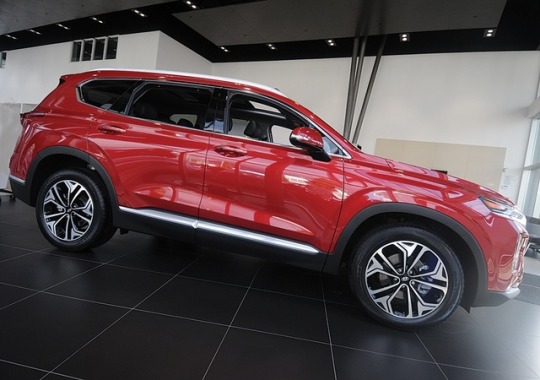
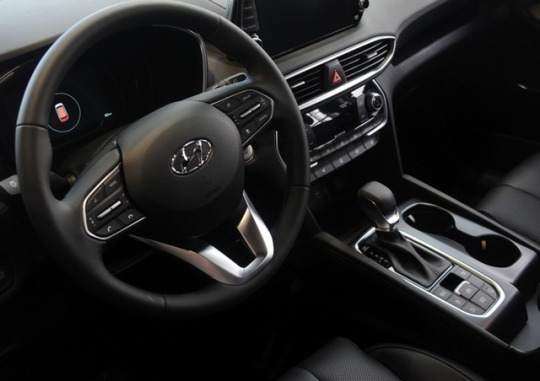

New Santa Fe leads the way for Hyundai
The 2019 Hyundai Santa Fe from Group 1 Hyundai replaces the five-passenger Santa Fe Sport. The seven-passenger 2018 version of the Santa Fe is now renamed as the Santa Fe XL, and a new eight-passenger “full-size” model will be making an appearance soon as the Palisade. The name Hyundai stands for modernity in the Korean language, and according to the vehicle maker this “H-Factor” is the word that represents the all-new Santa Fe accurately.
Hyundai is on the offence, unleashing multiple new products all within a span of just a couple of years.
In fact, with so many new models arriving, it can be hard to keep track of them all. There are no less than six new or redesigned SUVs already introduced or coming out in the next few years. Of these, the most significant entry is the all-new Hyundai 7-seater - the 2019 Santa Fe.
Design
Hyundai is the only global automaker to manufacture their own steel and use it in a framework they refer to as the “Superstructure.” This features structural adhesives placed strategically to protect critical areas for passengers, making it safer overall in the case of an accident. In addition, the 2019 Santa Fe now boasts such things as multi-link suspension setup, a stiffer body, and improved chassis all around. This results in a confident, sturdy ride that is fitting for this SUV.
The IIHS gives the 2019 Hyundai Santa Fe a Top Safety Pick + rating, but only if you choose a trim other than the base level. This is due to the inclusion of Hyundai SmartSense safety technology that is standard on all but the base model. The SmartSense safety includes the forward Collision-Avoidance, Lane Keep Assist, and Driver Attention Warning, to name the key items.
Two new safety features that are worth mentioning are the Rear Occupant Alert and the world’s first Safe Exit Assist. The Rear Occupant Alert will let the driver know if he or she leaves the vehicle and has left a child or pet in the back seat. The system will make a noise by sounding the horn and also send a message to the owner’s smartphone.
Safe Exit Assist will alert the driver by keeping the door locked if they attempt to open the door in an unsafe situation, such as the presence of an upcoming motorcycle, car, or bicycle approaching from the rear.
The interior feels roomy and airy due to a lower placed dashboard and larger windows, and quality materials add flair to the already functional display. The Apple CarPlay and Android Auto are standard on this model (Toyota, are you listening?). Other notable changes are roomier interior and a larger cargo capacity, which by the way, is accessed with a power lift gate (the cargo capacity is 2,019 litres with the seats folded flat and 1,016 litres with the seats up). All passengers can enjoy and travel in comfort with a generous amount of head, leg and shoulder room in this Hyundai.
Performance
There are two engine options available with the all-new Santa Fe. The standard, carried over 2.4-litre GDI engine produces 185 horsepower and 178 foot-pounds of torque. The better engine option is a 2.0-litre turbocharged GDI that produces 235 h.p. and 260 foot-pounds torque. Both options come with an eight-speed automatic transmission and an optional HTRAC All-Wheel Drive upgrade.
The 2.0-litre turbo four is much quicker than the base 2.4-litre non-turbo, hitting 100 kilometres per hour a few seconds earlier. The turbo four is smooth, quiet and highly refined, and its ample power makes you think that you might be driving an SUV with a V-6 engine.
The handling is well balanced and predictable, and the brakes feel more than adequate. The Santa Fe strikes a good balance between firmer, sportier German competitors such as the Audi Q5 and the softer, family-car style Japanese models like the Toyota RAV4. When compared directly face-to-face, however, the Honda CR-V still delivers better road character and the all-new Toyota RAV4 may also prove to be a formidable competitor.
Fuel economy for the 2.4-litre engine and front-wheel drive is 10.7/8.2/9.6 litres/100 kilometres for city/highway/combined, and 11.2/8.7/10.1 l/100 km if you choose all-wheel drive. For the upgraded 2.0-litre turbocharged engine, fuel economy is estimated to be 12.3/9.8/11.2 l/100 km.
Summary
In Canada, the 2019 Santa Fe comes in four trim levels: Essential, Preferred, Luxury, and Ultimate. I would recommend the Preferred trim and up, purely because none of the safety features beyond airbags and anti-lock brakes are included with the base level Essential trim.
Hyundai offers one of the best-backed five-year warranties on offer in Canada, which is another perk that may sweeten the deal for potential buyers.
Article source: https://www.nsnews.com/lifestyle/auto/review-new-santa-fe-leads-the-way-for-hyundai-1.23613016
0 notes
Text
Mazda CX-5, Cadillac CT5 et Expocam
Le 16 avril 2019
Les semaines se suivent et ne se ressemblent surtout pas. Cette semaine, il n’est pas question d’une auto de performance ni d’une camionnette pick-up de 100 000 $ mais d’un petit VUS des plus populaires au Québec, le Mazda CX-5. Malgré le fait que ce soit un petit utilitaire un peu anonyme, sachez que c’est le véhicule le plus populaire de la marque en Amérique! Et combien de fois a-t-il été mis en nomination pour diverses mentions? Ça ne se compte plus!
J’ai donc mis la main sur la version 2019 de ce CX5 la semaine dernière. De l’extérieur, le petit VUS (qui doit faire face à une concurrence des plus vives incluant les Ford escape, Chevrolet Equinox, Toyota RAV4, Nissan Rogue, Jeep Compass et j’en passe) ne semble pas avoir été modifié depuis son redesign de 2017. Mais on dirait que sa ligne est intemporelle. Toutefois, à l’intérieur et sous le capot, c’est une toute autre histoire.
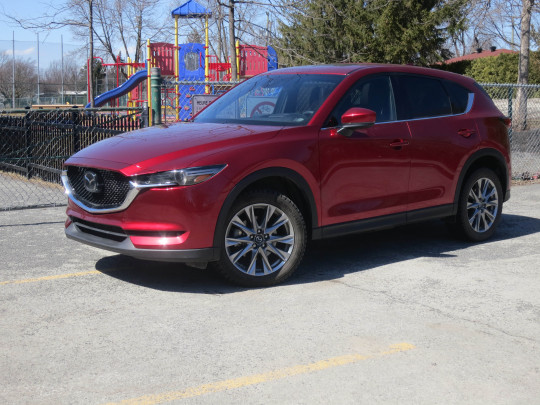
Le petit VUS CX5 de Mazda est désormais disponible en version de luxe de performance Signature. (Photo Éric Descarries)
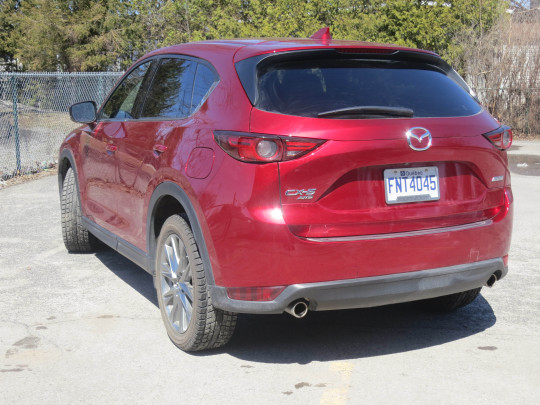
Toujours aussi reconnaissable, le CX-5. (Photo Éric Descarries)
Au départ, soulignons l’arrivée de la nouvelle version Signature haut de gamme dont il est question ici. Cette version combine la vivacité de la version GT avec son nouveau moteur turbocompressé à une finition intérieure plus poussée que jamais. Désormais, le CX-5 n’est pas plus joli que plusieurs de ses concurrents, il est aussi plus élaboré et confortable et surtout plus performant
Si vous êtes amateur de performances ou de puissance, vous serez plus intéressés par le quatre cylindres SKYACTIV-G de 2,5 litres qui, grâce à l’ajout d’un turbocompresseur, développe 250 chevaux (avec de l’essence Super, spécifions-le) et 310 livres-pied de couple. Vous aurez compris qu’il s’agit du même moteur que l’on retrouve sous le capot de certaines berlines Mazda6 et VUM CX-9! La boîte de vitesses automatique demeure à six rapports qui peuvent être changés manuellement. Les CX-5 de base sont à traction avant mais la version Signature dont il est question ici est à traction intégrale. Notons que les ingénieurs de Mazda ont aussi révisé le châssis et la suspension pour mieux y recevoir cette nouvelle puissance tout en demeurant très confortable.
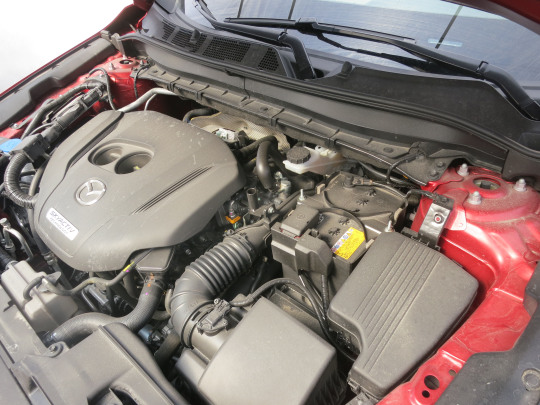
Le CX-5 Signature jouit du moteur de 2,5 litres avec turbocompresseur. (Photo Éric Descarries)
À l’intérieur, le conducteur est accueilli par un tableau de bord simple mais efficace. L’instrumentation est regroupée devant ses yeux et elle est très lisible. Avec la version Signature, il a aussi droit à un centre d’information TFT de 7 pouces. Au centre se trouvent deux bouches d’aération surmontées d’un écran de dimensions moyennes pour le GPS, la caméra de marche arrière et autres fonctions que l’on retrouve habituellement avec cet accessoire incluant Apple CarPlay et Android Auto. Le volant, heureusement, n’est pas surchargé de commandes. La console centrale ne l’est pas non plus ne retenant que le levier de vitesses, la mollette pour l’écran et quelques espaces de rangement.
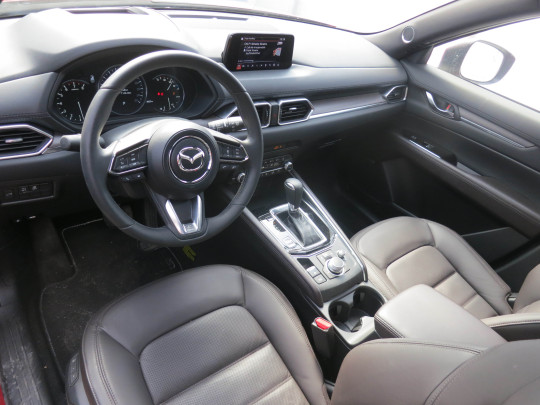
Le tableau de bord semble simple mais il est élégant et efficace. (Photo Éric Descarries)
Les concepteurs de Mazda ont aussi fait du bon boulot en redessinant les sièges baquets d’avant qui sont, sur le Signature, chauffants et ventilés. Ils sont surtout très confortables tout comme ceux d’arrière qui peuvent facilement accepter deux adultes quoique l’espace pour les jambes peut sembler un peu restreint. Par contre, le CX-5 conserve son bon espace arrière pour le cargo auquel on accède par un hayon à commande électrique.
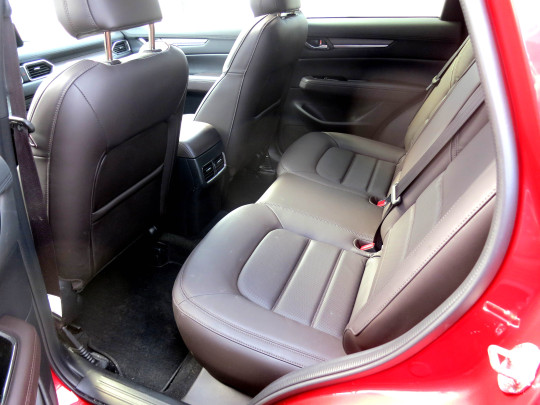
Les places arrière sont accueillantes mais il pourrait y avoir plus de place pour les jambes. (Photo Éric Descarries)
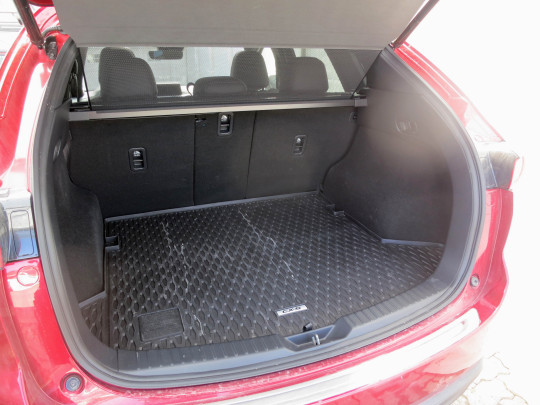
Le coffre est suffisant pour les besoins de la cause. (Photo Éric Descarries)
Une conduite différente
Outre le confort apporté par le choix des matériaux à l’intérieur du Mazda CX-5 Signature, notamment le cuir de grande qualité, c’est avec les yeux que l’on peut distinguer les changements physiques apportés à cet iconique véhicule. Toutefois, au volant, c’est une toute autre histoire.
Avouons-le, le CX-5 n’a jamais été un véhicule excitant à conduire. Bien, agréable et relativement confortable mais pas excitant. Tout change avec l’arrivée du nouveau moteur turbocompressé. Que diriez-vous d’accélérations tournant autour des sept secondes pour atteindre les 100 km/h? Et si l’on joue un peu avec le levier de vitesses, on peut plus facilement exploiter la camionnette avec une suspension mieux adaptée à une conduite presque sportive. Néanmoins, même sollicité, le petit moteur demeure relativement discret. Il n’est pas complètement silencieux mais il n’est pas des plus bruyants si je le compare, disons, au RAV4 discuté ici il y a quelques semaines. On en sent le couple à des régimes moins élevés que dans le passé alors que le turbocompresseur ne produit aucun coup dans ses interventions. Quant à la boîte à six rapports, le CX-5 n’a pas besoin de plus de vitesses. Cette boîte fait très bien l’affaire sans soubresauts. La tenue de route est accentuée par l’approche vectorielle de la traction intégrale adoptée par Mazda. La visibilité est vraiment bonne tout le tour. En passant, ce petit VUS (ou VUM, c’est selon), n’est certes pas un tout-terrain mais sa traction intégrale peut être un atout en situations hivernales. Mon véhicule d’essai était équipé de pneus Yokohama IceGuard 51 d’hiver qui, dans le passé, se sont avérés à la hauteur de la situation avec d’autres véhicules dans la neige ou sur pavé glacé ou humide.
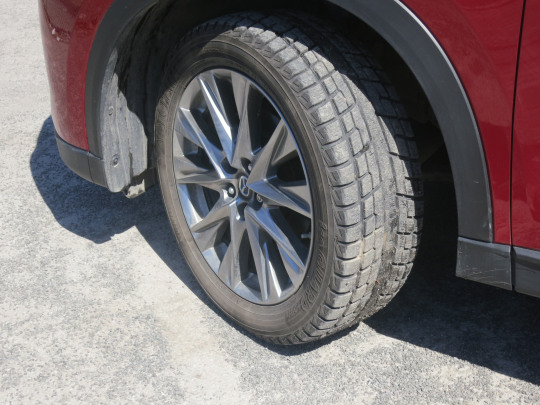
Mazda avait chaussé mon CX-5 d’essai d’efficaces pneus d’hiver de Yokohama. (Photo Éric Descarries)
En ce qui a trait à la consommation, avec une conduite surtout urbaine, ce petit véhicule m’a permis une consommation moyenne de 11,4 litres aux 100 km (alors qu’au tableau de bord, l’ordinateur indiquait une moyenne de 11,1 l/100 km).
Il y aurait tant à écrire sur la gamme CX5 qui débute à 27 850 $ qu’il faudrait des paragraphes pour tout couvrir. Toutefois, la popularité de ce véhicule au Québec est une preuve que ce petit VUS est non seulement joli mais aussi bien conçu et bien construit malgré une image un peu plus discrète que certains de ses concurrents. La version haut de gamme Signature qui me fut confiée affichait une facture de 40 950 $ ce qui est très concurrentiel, croyez-le ou non. Ne soyez pas surpris si Mazda n’y change pas grand-chose au cours des années à suivre. Comme le disent les Américains : «Si ce n’est pas brisé, pas besoin de le réparer!». Et c’est comme cela qu’on aime le CX5…encore plus en version Signature!
Une nouvelle Cadillac intermédiaire, la CT5
La semaine dernière, la division Cadillac de General Motors m’invitait à Detroit pour me donner un avant-goût de sa nouvelle berline intermédiaire CT5 (Cadillac Touring 5) qui devrait remplacer l’actuelle CTS. L’auto devrait être dévoilée au public au Salon de l’auto de New York cette semaine.
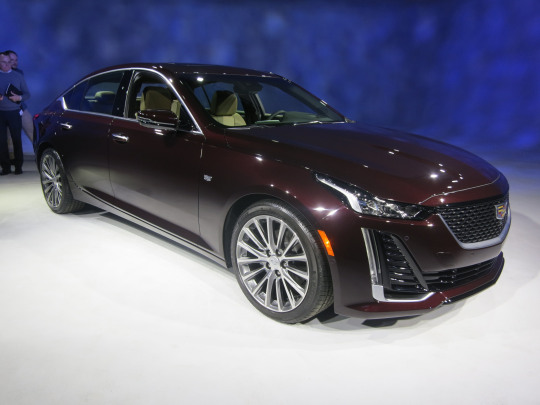
La nouvelle Cadillac CT5 en version de luxe. (Photo Éric Descarries)
Basée sur une nouvelle plateforme, la CT5 sera d’abord une voiture moderne reposant sur une architecture à propulsion avec possibilité de traction intégrale. Elle sera livrable en trois finitions, Luxury, Premium Luxury et Sport, les deux dernières disponible avec les options Platinum. Tout y est nouveau, du moteur de base, un quatre cylindres turbocompressé de 2,0 litres (une version révisée du moteur qui est déjà livrable avec la CT6 de base) de 250 chevaux au moteur optionnel, un tout nouveau V6 biturbo de 335 chevaux. Les deux seront combinés à une boîte automatique à dix rapports. L’intérieur se distingue par un tableau de bord sobre mais élégant avec écran central d 10 pouces à haute définition. Tout y est simple mais de bon goût avec des matériaux haut de gamme.
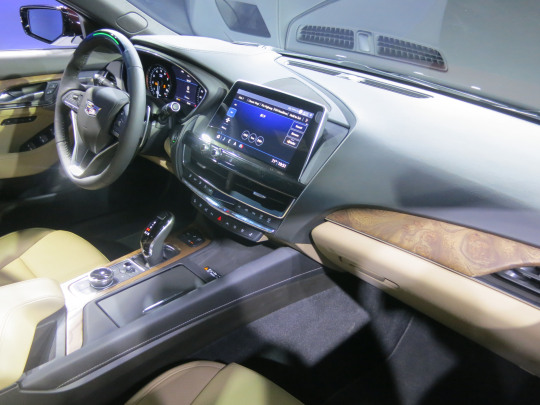
Le tableau de bord de la CT5. (Photo Éric Descarries)
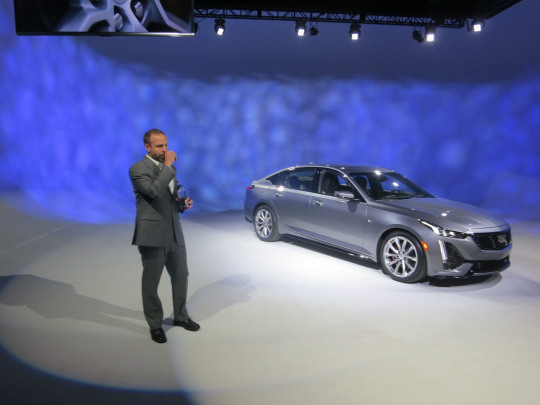
La CT5 sera commercialisée dès l’automne prochain à un prix qui reste à être défini…
La Cadillac CT5 en version Sport. (Photo Éric Descarries)
Le programme s’est terminé par une visite du centre Héritage de GM (ma troisième fois à ce centre privé du constructeur inaccessible au grand public) où j’ai pu y voir et revoir des classiques du grand constructeur…

Une vue d’une partie du musée de GM. (Photo Éric Descarries)
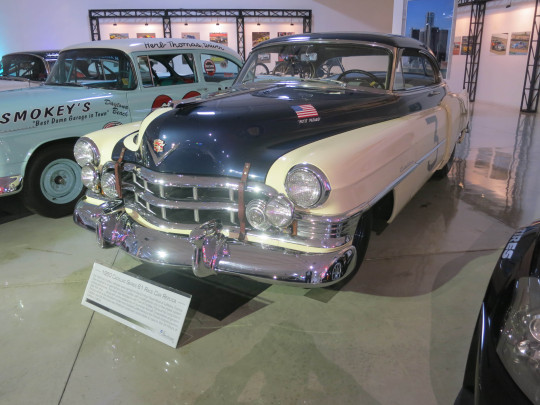
Cette Cadillac 1950 a participé aux 24 Heures du Mans de cette année-là! (Photo Éric Descarries)

Ma voiture préférée du musée? Cette majestueuse Cadillac 1931 à moteur V16 ! (Photo Éric Descarries)
L’Expocam
Encore une fois, la caravane des grandes expositions de camions poids lourd s’est arrêtée à Montréal, plus précisément à la place Bonaventure avec la tenue biannuelle de l’Expocam. Les amateurs de gros camions s’y étaient donné rendez-vous, certains pour y voir les plus récents modèles des grands constructeurs, les autres pour s’en procurer un! En voici quelques photos…
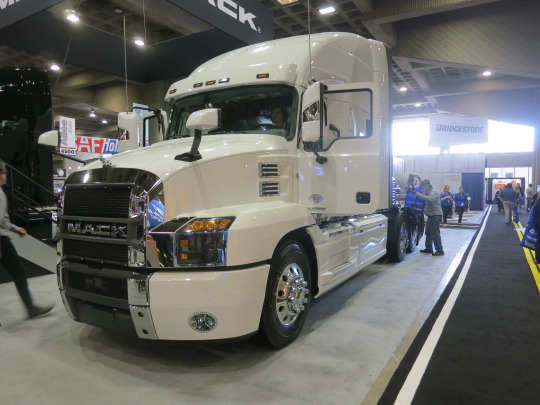
Mack y avait un de ses tout derniers modèles de tracteur de grand-route. (Photo Éric Descarries)
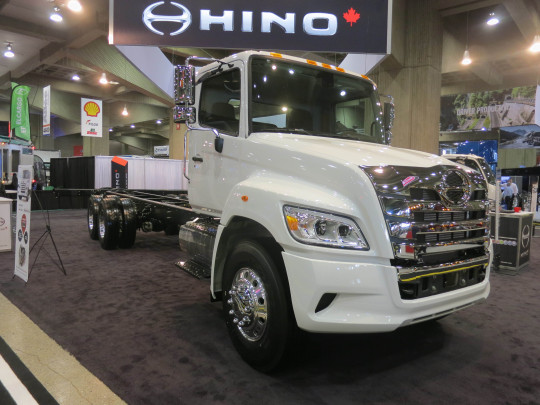
Hino exposait à l’Expocam son tout nouveau camion poids lourd! (Photo Éric Descarries)
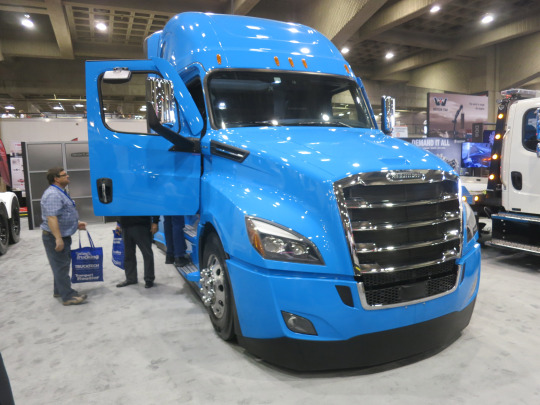
Toujours impressionnant les gros camions de Freightliner, n’est-ce pas? (Photo Éric Descarries)
0 notes
Text
2019 Chevrolet Spark Affordable when it's tempting
2019 Chevrolet Spark Affordable when it's tempting

2019 Chevrolet Spark Affordable when it's tempting
The 2019 Chevrolet Spark price starting from $ 9,995 (before transportation and preparation costs), the 2019 Chevrolet Spark is officially the cheapest new car on the market. It's enticing, considering the modernity of this small car compared to its obsolete competitors. But beware of the list of options, because it will inflate the price of your Spark to a ridiculous level. When Koreans get involved With us since 2013, redesigned for 2016 and updated for the 2019 model year, the Spark competes mainly against the Nissan Micra , the Fiat 500 , and the Mitsubishi Mirage in the category of city cars , a segment that decreases with consumers North Americans because of the popularity of SUVs. Why does GM persist with its small subcompact after removing almost all cars from its lineup?

2019 Chevrolet Spark Affordable when it's tempting
The reason is simple: the 2019 Chevrolet Spark is not an American car, but Korean, designed and assembled by the GM Korea division, in the suburbs of Seoul. Do you remember Daewoo, the South Korean brand that did not last long in the early 2000s? She never left us, actually. She's simply hiding behind a Chevrolet crest since all this time! This alliance not only allows the Spark to continue to exist for overseas markets where subcompacts are still in vogue, but also to take advantage of the recent technical know-how of Koreans in small cars. When compared to a Micra or a Mirage, the Spark is by far the most sophisticated city car of the trio. The Chevrolet Spark engine The changes for 2019 are minimal, but substantial. Design side, it remains relatively unchanged, except for the addition of a new grille. Under the hood, the 1.4-liter four-cylinder still produces 98 horsepower. This engine can always be paired with either a five-speed manual gearbox or a continuously variable automatic (CVT). The other novelty is the addition of an emergency braking system in the event of an imminent collision, a first in this segment, offered as an option for better-equipped versions. The Spark remains the only city car to come standard with ten airbags, a seven-inch touch screen, a Wi-Fi (subscription) and an Android Auto / Apple CarPlay integration. To say that a Rolls-Royce Cullinan of over $ 400,000 is not even compatible with Apple CarPlay ... That's his strength, at Spark: the windfall. But only when it suits him, because our trial version, equipped with a CVT box, was stocked with all the options offered by the catalog, amounting to a retail price of more than $ 22,885. A nonsense.

2019 Chevrolet Spark Affordable when it's tempting
Neither expensive nor painful The good news is that even if you stick to the basic declination, the Chevrolet Spark is by no means laborious to drive. Although not as fast or as sporty as a Micra, it is surprisingly stable and quiet at high speed, with no problem tracking traffic, even with four passengers on board. In addition, its interior is well assembled, with quality materials more than acceptable and a beautiful design given the price required. However, we criticize its seats for being too hard, granting very little support for larger passengers. The small engine, unsurprisingly, offers no acceleration and no intoxicating sound, but thanks to the fact that it develops its torque of 94 lb-ft at low revs, it remains strong and well equipped for daily tasks. It is useless to make it scream up to its limiter to advance the car, which allows the Chevy Spark to triumph over its competitors in terms of refinement.

2019 Chevrolet Spark Affordable when it's tempting
The CVT box works well but sometimes hesitates before reacting. It does a lot of good work by maximizing the available power range. However, we recommend that you opt for the manual gearbox because it will be easier and more enjoyable to use everything the Chevy Spark has in the belly. We were also satisfied with the gas consumption of this microbagnole. In recent years, advances in technology have meant that larger size vehicles - such as compact, mid-size, and some SUVs - display fuel consumption data almost identical to that of subcompacts. On our side, in winter, mixed city / highway driving, our Spark 2019 stood below 7 L / 100 km, which is excellent even for the niche. And let's not forget the fuel that only cost us $ 30! The little girl in a world of giants What charmed us most about the Spark is its small size. Admittedly, its interior can be narrow for grown-ups, especially at the rear, and if you do not lower the seat, the trunk is narrow (314 liters). But as an urban car, this miniaturization gives the Spark maneuverability and ease of use out of the ordinary. It feels light, responsive, ready to pounce and extremely fun to drive in traffic at high speed. In a city like Montreal, the Spark is in its environment: easy to park and not at all cumbersome. In other words, if you care about your energy-efficient footprint and are not yet ready to start paying for an electric car, the Spark is a sensible ecological choice. It uses almost no gas, does not take up much space, and has one of the lowest greenhouse gas emissions in the industry And if it is only for a budget reason that it caught your eye, know that it is not a bad car so far. On the contrary, the Chevrolet Spark 2019 will remind you that a small car "not expensive", it is not only good for the wallet, but also for your state of mind.

2019 Chevrolet Spark Affordable when it's tempting
Chevrolet Spark Evaluation Sheet Trial version -LT (auto) Price range -nd Chevrolet Spark price under review -$ 19,550 Basic warranty -3 years / 60,000 km Consumption (city / road / observed) -7.8 / 6.2 / 6.8 L / 100km options -nd Competitive models -BMW i3 , Fiat 500 , Mitsubishi i-MiEV , Mitsubishi Mirage , Nissan Micra , smart Fortwo Strong points -Affordable base price -Attractive standard equipment -Amazingly refined Weak points -Get expensive once well equipped -Small chest -Uncomfortable seats for tall people Consumption -Throughout our test, in winter, we recorded an average consumption of 6.8 L / 100 km. Comfort -The cabin of the Spark can accommodate four adults, but we do not recommend it for long journeys, because its seats are hard and deprived of lumbar support. performances -We do not buy a Spark to go run on the weekend! Multimedia system -Chevrolet MyLink is one of the best systems in the industry because of its simplicity and ergonomics. Comes with a Wi-Fi terminal, compatible with Android Auto and Apple CarPlay. Driving approval -Although it is not super fast, the Spark is a pleasant little car to drive, especially in the city. General appreciation -With such a low base price, attractive standard features and a level of sophistication superior to its rivals, it's hard to argue against this charming city-dweller. -SEE ALSO:
Toyota RAV4 2019 strongly hybrid
Porsche 911 Carrera 4S Cabriolet a real supercar
Volkswagen T-Roc R 2019 - Cars Medd
from Blogger https://ift.tt/2BWuMDC via IFTTT
0 notes
Text
TOYOTA RAV4 NOUVEAU NIVEAU DE FINITION

TOYOTA RAV4 NOUVEAU NIVEAU DE FINITION
Toyota RAV4 2019
Toyota RAV4 2019 le RAV4 2019 devrait atteindre les planchers des concessionnaires plus tard cette année. On peut s'attendre à des changements importants au niveau de la conception extérieure et de la puissance de cette voiture très attendue. C'est ce que l'on peut attendre du Toyota RAV4 2019. (adsbygoogle = window.adsbygoogle || ).push({});
Nouveaux niveaux de finition
L'extérieur du RAV4 est souvent caractérisé comme étant un véhicule multi segment moderne. Toyota a porté le RAV4 2019 à un niveau supérieur de design moderne et y a ajouté quelques caractéristiques extérieures excitantes. Il se caractérise par des lignes plus audacieuses, des détails d'ailes en métal et une nouvelle calandre audacieuse. Toyota décrit ces mises à jour comme ciselées. L'ensemble du RAV4 est également plus long en taille avec une longueur supplémentaire de 1,2 pouce. Les niveaux de finition disponibles comprennent le RAV4 Adventure, le RAV4 Limited et le XSE Hybrid. Il est toujours possible que quelques niveaux de finition supplémentaires soient ajoutés plus près de la date de sortie réelle. (adsbygoogle = window.adsbygoogle || ).push({});
Intérieur
L'intérieur du RAV4 est connu pour être à la fois sportif et confortable. Le modèle 2019 apportera une touche de luxe supplémentaire disponible, le toit ouvrant panoramique. On retrouve le luxe dans tout l'habitacle du RAV4 avec des sièges en cuir à 8 réglages électriques, un système audio à 11 haut-parleurs et une caméra de recul à rétroviseur exclusive. Toyota a également redessiné l'aménagement intérieur en gardant à l'esprit une ergonomie optimale. Chacune des caractéristiques technologiques ajoutées est facilement accessible depuis le siège du conducteur grâce à un nouvel écran d'affichage central plus grand.
(adsbygoogle = window.adsbygoogle || ).push({});
Puissance
Comme si le nouveau RAV4 n'avait pas déjà connu toute une série de changements passionnants, il est également construit sur une nouvelle plateforme. Cela modifiera considérablement la puissance et la maniabilité. La nouvelle plateforme RAV4 est partagée avec la Toyota Camry. La nouvelle plate-forme améliorera la capacité du RAV4 à être performant en tout-terrain. En retour, cela améliorera également l'efficacité et la durabilité de la conduite quotidienne. Le système de traction intégrale inclus améliore encore les conditions de conduite en tout-terrain. En conclusion, le RAV4 2019 sera doté d'un moteur quatre cylindres de 2,5 litres avec transmission automatique à changement de vitesse direct et suspension sport spéciale. Il y aura également un moteur hybride distinct qui comprendra le moteur Hybrid System II avec une transmission à variation continue pour un rendement optimal. (adsbygoogle = window.adsbygoogle || ).push({});
Technologie
Si l'on considère que Toyota a augmenté la modernité et la fonctionnalité du RAV4 2019, on peut également s'attendre à des améliorations au niveau de la technologie intérieure. Le RAV4 sera équipé de série du système de sécurité Toyota TSS qui comprend le freinage d'urgence, le régulateur de vitesse adaptatif, l'avertissement de changement de voie et l'assistance à la direction. Il comprend également les technologies avancées d'aide au traçage de voie et d'aide à la signalisation routière. De plus, la technologie améliorera le confort et le divertissement de l'intérieur du RAV4. L'écran tactile 7 pouces amélioré est équipé du système multimédia Entune et de la fonction smartphone via Apple CarPlay ou Android Autio. Enfin, le v��hicule sera doté d'un point d'accès Wi-Fi pour les utilisateurs Verizon. Vous avez aimé cet article ? Partagez et commentez ! Read the full article
0 notes